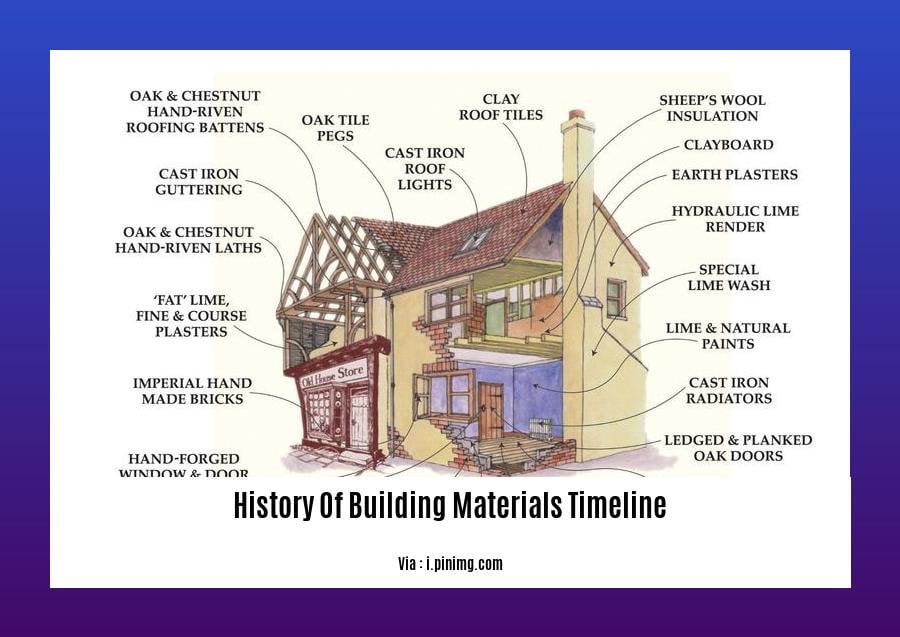Welcome to “Concrete Facts: Unveiling the Composition, Strength, and Sustainability.” In this article, we will delve into the fascinating world of concrete, exploring its composition, strength, and sustainable aspects. As an experienced civil engineer specializing in construction materials, I am excited to share my knowledge and expertise on this subject. Get ready to discover some intriguing facts about the properties and limitations of concrete, its role in modern construction, and the crucial steps to ensure its durability. Let’s embark on this journey to uncover valuable insights into the captivating world of concrete.

Key Takeaways:
- The Romans were the pioneers in using concrete, and their structures still exist today.
- Concrete is a versatile material that is resistant to fire and water.
- The Trump International Hotel in Las Vegas is the largest concrete structure globally.
- Concrete is the most widely-used material worldwide.
- Over 10 billion tons of concrete are produced annually, second only to water in consumption.
- A concrete mixture consists of about 60-75% aggregate, 15% cement and water, and 5-8% air.
- Concrete has a lifespan of 25 to 50 years, surpassing other materials like seashell, stone, and asphalt.
- Concrete driveways contain cement, with more than 4 billion tons of cement produced annually.
- Concrete is twice as widely used in construction compared to any other building material due to its practicality and abundance of limestone.
- Concrete exhibits high resistance to fire and water.
Facts About Concrete
The world of construction relies heavily on concrete, a versatile and durable material that has been used for centuries. In this article, we will uncover some fascinating facts about concrete, ranging from its composition to its strength and sustainability. So, let’s dive right in!
The Origins of Concrete
Concrete has been around for a long time, with the Romans being the first to use it in their structures. In fact, some of their concrete structures still stand today, showcasing the durability and longevity of this material.
The Versatility of Concrete
One of the remarkable properties of concrete is its resistance to both fire and water. This makes it an ideal choice for a wide range of applications, whether it be building structures or creating infrastructure that needs to withstand challenging environmental conditions.
Concrete’s Global Impact
Concrete is the most-used material in the world due to its practicality and abundance of limestone. It is estimated that more than 10 billion tons of concrete are produced annually, making it the second most consumed material in the world after water. This highlights the crucial role concrete plays in shaping our modern world.
Exploring Concrete’s Composition
A concrete mixture typically consists of various components. About 60-75% of the mixture is made up of aggregate, such as crushed stone or gravel, which provides strength and stability. The mixture also includes around 15% cement, which acts as a binder, holding the aggregate together. The remaining percentage is water and air, contributing to the workability and durability of the concrete.
The Trump International Hotel in Las Vegas
Did you know that the Trump International Hotel in Las Vegas is the largest concrete structure in the world? Its impressive size showcases the immense strength and load-bearing capacity of concrete. This is just one example of how concrete is utilized in creating massive structures that stand tall and endure the test of time.
Concrete’s Longevity
When properly designed, constructed, and maintained, concrete can last for an impressive 25 to 50 years. Unlike other materials like seashell, stone, and asphalt, concrete offers a longer lifespan, making it a sustainable choice for various construction projects.
The Role of Cement
Cement is a key ingredient in concrete driveways. In fact, over 4 billion tons of cement are produced annually to meet the demands of construction. It serves as the binding element in the concrete mixture, providing the necessary strength and cohesion.
The Environmental Impact
While concrete offers many advantages, it is important to consider its environmental impact. Concrete production contributes to carbon dioxide emissions, making it a significant source of greenhouse gases. However, efforts are being made to develop more sustainable alternatives, such as incorporating recycled materials or using advanced manufacturing techniques.
In conclusion, concrete is a remarkable material that has shaped our world for centuries. From its origins in ancient Rome to its modern-day applications, concrete offers strength, durability, and versatility. By understanding the composition, strength, and sustainability of concrete, we can make informed decisions and strive for a more sustainable future in the world of construction.
Check out these fascinating fun facts about grass! fun facts about grass
Concrete Facts: Unveiling the Composition, Strength, and Sustainability
The world of construction revolves around one material that stands strong and versatile – concrete. With its wide range of applications, durability, and impact on global CO2 production, concrete remains an essential building material. In this article, we uncover some fascinating facts about the composition, strength, and sustainability of concrete. So let’s dive in and explore the world of concrete!
Global Use and Production
Concrete holds an impressive position in the construction industry, being the most widely used building material globally. Annually, over 10 billion tons of concrete are produced worldwide, surpassing any other material in terms of sheer quantity. In fact, it’s even more widely used than wood, steel, plastic, and aluminum combined. Cement, a crucial component of concrete, is produced in staggering quantities, exceeding 4 billion tons each year. The extensive use and production of concrete contribute significantly to global CO2 emissions, accounting for about 5% of annual anthropogenic CO2 production.
Longevity and Durability
One of the remarkable qualities of concrete is its impressive longevity and durability. Concrete structures can last anywhere from 25 to 50 years, and some ancient concrete structures have withstood the test of time for thousands of years. A prime example is the Pantheon in Rome, a remarkable architectural feat made of unreinforced concrete. This awe-inspiring dome construction has stood strong for over 2000 years. Concrete’s durability makes it an ideal choice for various applications, ensuring the longevity of our built environment.
Composition and Production
So what exactly makes up this strong and versatile material? A typical concrete mixture comprises four primary components: aggregate, cement, water, and air. Aggregate, which can consist of crushed stone, gravel, sand, or recycled materials, accounts for 60-75% of the mixture. Cement, making up around 15%, binds the aggregate particles together when mixed with water. The water plays a vital role in the curing process, allowing the mixture to harden and form a solid material. Additionally, a small percentage of air is intentionally entrained in concrete to enhance its workability and freeze-thaw resistance.
Uses and Applications
Concrete’s versatility knows no bounds when it comes to its applications in the world of construction. It is widely used in the creation of buildings, roads, bridges, and various types of infrastructure. This versatility arises from the fact that concrete can be poured into place as a liquid, allowing it to conform to any shape, and then hardens to resemble natural rock. Whether it’s towering skyscrapers, sturdy bridges, or smooth pavements, the utilization of concrete in diverse construction projects remains unparalleled.
Recycling and Sustainability
Concerns about environmental impact have led to increased efforts in promoting sustainable practices in concrete production and recycling. Concrete can be recycled and reused in new construction projects, reducing waste and minimizing the extraction of natural resources. By incorporating recycled concrete into new structures, we can significantly reduce both the environmental footprint and the demand for fresh concrete production.
Key Takeaways:
- Concrete is the most widely used building material globally, with over 10 billion tons produced annually.
- Cement production, a key component of concrete, exceeds 4 billion tons each year.
- Concrete can last for 25 to 50 years, and ancient structures like the Pantheon in Rome stand as a testament to its longevity.
- The composition of concrete consists of aggregate, cement, water, and air.
- Concrete’s versatility allows it to be used in various construction applications, from buildings to roads and bridges.
- Recycling concrete promotes sustainability by reducing waste and the extraction of natural resources.
To learn more about concrete and its significance, visit the following sources:
Concrete, with its remarkable composition, strength, and sustainability, remains an indispensable material in the modern construction industry. By harnessing the knowledge and implementing sustainable practices, we can continue to build a resilient and environmentally conscious future.
Note: This article is intended to provide information and facts about concrete. It does not provide instructions or guidelines for specific construction projects. For professional advice, consult with experienced civil engineers or construction experts.
Properties of Concrete
Concrete is a remarkable material with a wide range of properties that make it suitable for various construction applications. Understanding the properties of concrete is essential for designing and evaluating concrete structures. In this article, we will unveil the key properties of concrete and explore their significance in the world of construction.
Coefficient of Thermal Expansion
One of the notable properties of concrete is its coefficient of thermal expansion. This property refers to how much concrete expands or contracts with changes in temperature. Concrete has a low coefficient of thermal expansion, which means it remains relatively stable when exposed to temperature fluctuations. This property is crucial in preventing structural damage and maintaining the integrity of concrete structures.
Shrinkage
As concrete matures, it undergoes a process called shrinkage. Shrinkage occurs due to the loss of moisture within the concrete, resulting in a reduction in volume. It is important to consider shrinkage during the design and construction phases, as excessive shrinkage can lead to cracks and structural issues in concrete elements. Proper curing techniques and the use of supplementary materials can help minimize shrinkage and mitigate its negative effects.
Creep
Concrete is also subject to a phenomenon called creep. Creep refers to the gradual deformation of concrete under sustained loads over time. Long-duration forces can cause the concrete to slowly deform, which can affect the overall performance and structural stability of concrete structures. Understanding the creep behavior of concrete is essential for designing structures that can withstand long-term loads and maintain their intended shape.
Strength
The strength of concrete is a vital property that determines its structural integrity. The primary source of concrete’s strength comes from the chemical reaction between cement and water, known as hydration. Concrete is inherently weak in tension but can be reinforced with steel to enhance its tensile strength. This makes it suitable for constructing buildings, bridges, and other structures that require the ability to withstand various loads and forces.
Porosity and Density
Concrete exhibits varying levels of porosity and density. Porosity refers to the presence of small voids or pores within the concrete matrix. These pores can affect the durability and permeability of concrete. On the other hand, density refers to the mass per unit volume of concrete. The typical density of concrete is around 2,400 kilograms per cubic meter (150 lb/cu ft). The porosity and density of concrete play a crucial role in determining its strength, durability, and resistance to environmental factors.
Compressive, Flexural, Tensile, and Elastic Properties
Concrete possesses different mechanical properties that influence its structural performance. The specific mix design and the curing process can significantly impact the compressive, flexural, tensile, and elastic properties of concrete. Compressive strength refers to concrete’s ability to resist compression or withstand heavy loads. Flexural strength relates to its ability to resist bending or cracking. Tensile strength refers to its capacity to resist forces that pull it apart. Elastic properties describe concrete’s ability to deform and then return to its original shape when subjected to external forces. Understanding these properties is crucial for designing and assessing the structural adequacy of concrete elements.
Key Takeaways:
- Concrete has a low coefficient of thermal expansion, making it stable against temperature changes.
- Shrinkage occurs in concrete as it matures and can lead to cracks if not properly managed.
- Creep is the gradual deformation of concrete under sustained loads over time.
- Concrete’s strength comes from the chemical reaction between cement and water, making it suitable for reinforcing structures.
- The porosity and density of concrete influence its durability, permeability, and resistance to environmental factors.
- Compressive, flexural, tensile, and elastic properties play a crucial role in determining the structural performance of concrete.
For more comprehensive information on different types of concrete, chemical properties of concrete, and its uses in construction, you can refer to the following sources:
Concrete Facts: Unveiling the Composition, Strength, and Sustainability
Concrete is an incredible building material that has stood the test of time. From ancient Roman structures to modern high-rise buildings, concrete has proven its durability and versatility. In this article, we will explore fascinating facts about concrete’s composition, strengths, and sustainability, uncovering the key elements that make it such an essential part of the construction industry.
The Composition of Concrete
Concrete is a mixture composed of several key components. While many people may think of cement as the primary ingredient, it actually makes up only a small portion of the mixture. The majority of concrete consists of aggregates such as gravel or sand, along with water and air. These components work together to create a strong and durable material capable of withstanding immense pressure.
To get a clearer picture of concrete’s composition, let’s consider the general proportions. Typically, the aggregate makes up around 60-75% of the mixture, while cement comprises approximately 15%. The remaining percentage is allocated to water and air. This balance of ingredients is crucial in achieving the desired strength, durability, and workability of the concrete.
The Strengths of Concrete
Concrete boasts incredible strengths that make it an ideal choice for various construction applications. Its compressive strength, which measures its ability to resist compression, is significantly high. However, concrete’s tensile strength, or ability to withstand tension, is comparatively low. To address this, reinforcement materials, such as steel, are often added to enhance its tensile strength.
Moreover, concrete offers excellent resistance to fire and water, making it a highly reliable material for structures like bridges, dams, and high-rise buildings. Its durability is further enhanced by a low coefficient of thermal expansion, meaning it remains stable even in the face of temperature fluctuations.
The Sustainability of Concrete
While concrete is undoubtedly a remarkable building material, its production does come with environmental considerations. The manufacturing of cement, a key component of concrete, contributes to carbon dioxide emissions. However, the industry is actively working towards developing more sustainable alternatives, such as low-carbon and carbon-neutral cements.
Additionally, recycling concrete plays a significant role in promoting sustainability. By reusing crushed concrete as aggregate, we reduce waste and minimize the extraction of natural resources. This recycling process not only benefits the environment but also helps conserve energy.
Key Takeaways:
- Concrete is composed of aggregates, cement, water, and air, with aggregates making up the largest proportion.
- Its high compressive strength and resistance to fire and water make it an excellent choice for construction projects.
- Concrete production contributes to carbon dioxide emissions, but sustainable alternatives and recycling efforts are being pursued.
- Recycling concrete helps reduce waste and conserve energy.
- Concrete’s durability and stability are attributed to its low coefficient of thermal expansion.
Citation:
– Encyclopedia Britannica. “Concrete | Definition, Composition, Uses, Types, & Facts.” Link
– Kidadl. “29 Concrete Facts That Will Help You Understand Its Importance.” Link

FAQ
Q1: What are some interesting facts about concrete?
A1: Some interesting facts about concrete include its use by the Romans, who built concrete structures that still stand today, and its status as the most widely used building material in the world. Additionally, the Trump International Hotel in Las Vegas holds the record as the largest concrete structure globally.
Q2: How much concrete is produced annually?
A2: Over 10 billion tons of concrete are produced annually, making it the most consumed material in the world after water.
Q3: What is the composition of a concrete mixture?
A3: A typical concrete mixture consists of 60-75% aggregate, 15% cement, water, and 5-8% air. These components combine to form the solid material through a curing process.
Q4: How long does concrete last?
A4: Concrete structures can last for 25 to 50 years or even longer. Some historical structures made of concrete, such as the Pantheon in Rome, have stood for thousands of years.
Q5: Is concrete a sustainable material?
A5: Concrete production contributes to global CO2 production, but it can be recycled and reused in new construction projects, reducing waste and environmental impact. By promoting sustainable practices in concrete production and recycling, its sustainability can be enhanced.
- HelpCare Plus: Revolutionizing Affordable and Accessible Healthcare - December 29, 2024
- Boom & Bucket: Your Digital Marketplace for Used Heavy Equipment - December 28, 2024
- Ankle Bones Crossword Clue: Solutions, Tips & Anatomical Insights - December 28, 2024














